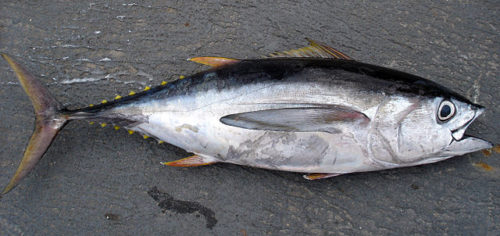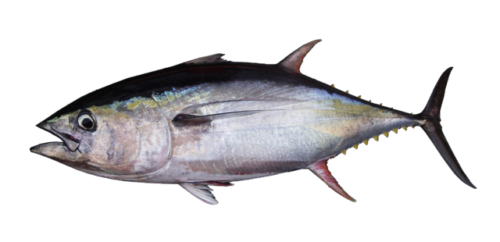Difference Between Ahi Tuna and Yellowfin Tuna

Ahi tuna (bigeye tuna)
Ahi Tuna vs. Yellowfin Tuna
The yellowfin tuna is a species of tuna that is found in subtropical and tropical waters around the world. It is frequently marketed as ahi tuna due to their similar features; however, they are two different species. The yellowfin fish is one of the largest tuna species and can weigh as much as 300 pounds. Some reports say that it can reach a maximum length of 239 centimeters.
Its name is attributed to the bright yellow color of its anal and second dorsal fins, finlets, and tail. The anal and second dorsal fins appear to be very long when the fish reach maturity. They sometimes reach far at the back near the tail, which gives the appearance of scimitars or sickles. Its pectoral fins are also longer as compared to the bluefin tuna; however, they are not as long as those found in the albacore tuna. Its main body has a metallic blue color, and its belly has a silver color.
The yellowfin tuna is an epipelagic fish that lives in different depths in the ocean. A study conducted using sonar technology revealed that although yellowfin tuna frequently lives in the first 100 meters of the ocean, it also penetrates the thermocline towards an area near the sea floor. In a study conducted in the Indian Ocean, a monitoring tag was placed in a yellowfin tuna to find where it usually stays. The findings revealed that the tuna spent 85% of its time in shallower depths (around 75 meters), but three dives were recorded wherein the fish reached more than 1,000 meters.
The ahi tuna (bigeye tuna) is a close relative of the yellowfin tuna. It is one of the typical food fish and game fish. This fish can grow up to 250 centimeters in length and can weigh as much as 400 pounds. According to a recreational fishing site, the heaviest recorded ahi tuna weighed 392 pounds. This ahi tuna was described as a large and deep-bodied streamlined fish with a large head and eyes.

Yellowfin Tuna
The ahi tuna can live in oxygen-poor and cold subsurface waters. Its blood has an oxygen extraction capability that allows it to live in waters that have poor oxygen conditions. The ahi tuna also has the ability to see clearly even in low light conditions. Its heart has an extraordinary ability to function well even in cold waters; however, it needs to periodically return to warmer waters to warm its body.
As compared to the yellowfin tuna, the ahi tuna can live longer. Records say that the usual lifespan of an ahi tuna is twelve years. This species usually reaches maturity at the age of four. Breeding usually happens during the months of June and July in the tropical areas of the Atlantic Ocean, and in January to February in the Gulf of Guinea.
State-of-the-art satellite tracking systems have shown that the ahi tuna spends most of its time diving deep into the ocean; it sometimes reaches a depth of 500 meters during daytime. The ahi tuna has also been tracked entering areas with temperatures as low as 5 °C. This movement is thought to occur in response to the vertical migrations of prey that the ahi tuna feeds on.
Summary:
- The yellowfin tuna lives in tropical and subtropical waters.
- The yellowfin tuna gets its name due to the presence of a bright yellow color in its fins and tail.
- The ahi tuna is frequently associated with the yellowfin tuna due to their similar features.
- The ahi tuna can live longer than the yellowfin tuna.
- Due to the extraordinary oxygen extraction capability of the ahi tuna, it can live in areas that have low oxygen.
- Differences Between Fraternity And Sorority - January 8, 2014
- Differences Between Lucite and Plastic - January 7, 2014
- Differences Between Oil and Butter - January 6, 2014
Search DifferenceBetween.net :
1 Comment
Leave a Response
References :
[0]https://commons.wikimedia.org/wiki/File:Thunnus_obesus_(bigeye_tuna).jpg
[1]https://commons.wikimedia.org/wiki/File:Yellowfin-transp.png

If a Big Eye and a yellowfin of the same size are caught, how can we tell them apart?